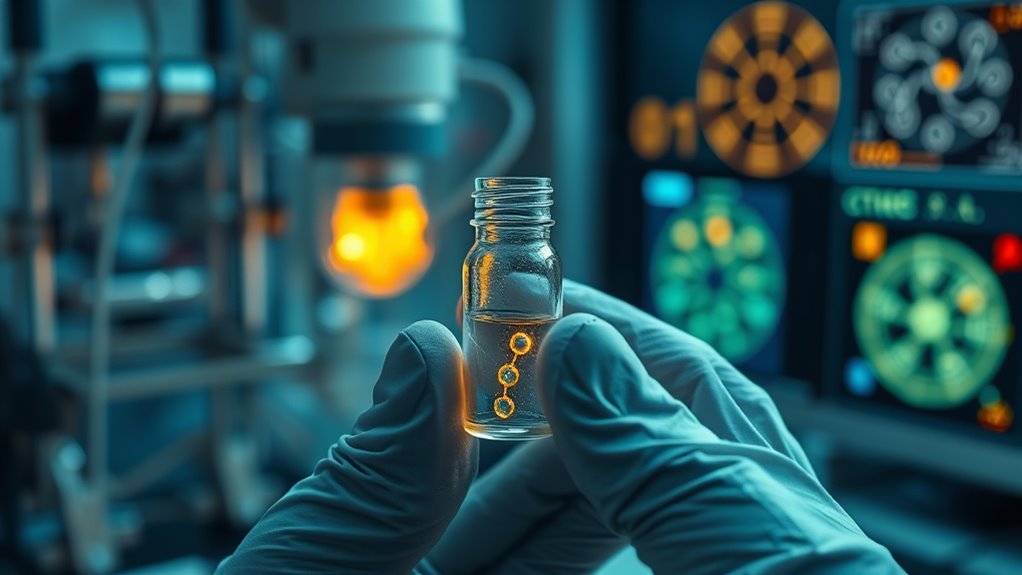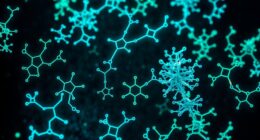Chemistry plays a key role in designing targeted cancer radiopharmaceuticals that deliver radiation precisely where it’s needed. By attaching radioactive isotopes to molecules that recognize cancer-specific markers, chemistry guarantees the radiation is transported directly to tumor cells, sparing healthy tissue. Stable chemical linkages keep isotopes secure during circulation, and tailored isotope selection optimizes treatment effects. Exploring how these innovations work together reveals the fascinating science behind effective, personalized cancer therapies—continue to find out more.
Key Takeaways
- Chemistry enables stable attachment of radioactive isotopes to targeting molecules for precise delivery.
- Molecular recognition guides radiopharmaceuticals directly to cancer cells, minimizing damage to healthy tissue.
- Chemical design ensures isotopes release radiation specifically at tumor sites, enhancing treatment accuracy.
- Selection of appropriate isotopes with suitable half-lives optimizes therapeutic effectiveness and safety.
- Advances in chemical synthesis improve targeting molecule specificity, enabling personalized cancer treatment.

Have you ever wondered how targeted cancer radiopharmaceuticals are revolutionizing cancer treatment? It all comes down to how precisely they deliver radiation directly to cancer cells, sparing healthy tissue and reducing side effects. At the heart of this innovation is the concept of radioisotope delivery coupled with molecular targeting. Instead of broad, systemic radiation, these therapies harness specially designed molecules that seek out cancer cells with remarkable accuracy.
Targeted radiopharmaceuticals deliver precise radiation to cancer cells, minimizing damage to healthy tissue.
This targeted approach means you can attack tumors more effectively while minimizing collateral damage, leading to better outcomes and fewer complications.
The process begins with the design of a radiopharmaceutical that combines a radioactive isotope with a molecule that recognizes and binds to specific markers on cancer cells. This molecular targeting is essential because cancer cells often display unique surface proteins or receptors not found on normal cells.
By exploiting these differences, scientists create agents that home in on the tumor with high specificity. Once administered, the radiopharmaceutical navigates through your bloodstream, guided by the molecular recognition process, to find its target.
This targeted delivery ensures that the radiation dose is concentrated exactly where it’s needed, rather than dispersed throughout the body. The chemistry behind these agents involves sophisticated isotope selection to optimize therapeutic efficacy and safety.
Radioisotope delivery is a sophisticated process, involving the choice of an appropriate radioactive isotope that emits radiation capable of destroying cancer cells. The isotope must have a suitable half-life to reach the tumor, deliver an effective dose, and then decay safely.
The chemical linkage between the isotope and the targeting molecule is designed to be stable during circulation but to release the radiation once bound to the tumor.
This precision in delivery is what makes targeted radiopharmaceuticals so promising—they’re not just throwing radiation at the area in hopes of hitting the cancer; they’re aiming directly at it with purpose-built accuracy.
This combination of radioisotope delivery and molecular targeting is transforming how we treat cancer. It allows for personalized medicine approaches, where treatments are tailored based on the specific markers present on a patient’s tumor.
The chemistry behind these agents ensures that the radiation hits only the cancer cells, reducing damage to healthy tissue and improving quality of life.
Furthermore, advances in cancer-specific markers detection enable the development of even more precise targeting molecules, expanding the potential applications of radiopharmaceuticals across various cancer types.
As research advances, these targeted radiopharmaceuticals are becoming more effective, with new isotopes and targeting molecules being developed to widen their applicability across different cancer types.
Ultimately, this precise chemistry-driven approach is changing the landscape of cancer therapy, offering hope for more effective and less invasive treatment options.
Frequently Asked Questions
How Do Radiopharmaceuticals Differentiate Between Cancerous and Healthy Cells?
You see, radiopharmaceuticals differentiate between cancerous and healthy cells through molecular targeting and receptor specificity.
They’re designed to seek out specific molecules or receptors unique to cancer cells. When you administer these agents, they bind selectively to cancer cell receptors, delivering radiation precisely where it’s needed.
This targeted approach minimizes damage to healthy tissue and maximizes the treatment’s effectiveness, making therapies safer and more efficient.
What Are the Main Challenges in Developing Targeted Radiopharmaceuticals?
Imagine steering a maze where each turn is critical—developing targeted radiopharmaceuticals faces similar hurdles. You must perfect drug delivery systems to guarantee radiation hits only cancer cells, avoiding healthy tissue.
Radiation resistance in tumors can act like armor, making treatments less effective. Overcoming these challenges requires precise chemistry, innovative delivery methods, and strategies to counteract resistance, ensuring you deliver the right dose to the right spot with minimal collateral damage.
How Long Do Radiopharmaceuticals Typically Stay Active in the Body?
You might wonder how long radiopharmaceuticals stay active in your body. Their activity depends on radioactive decay and biological half-life; decay determines how quickly the radiation diminishes, while biological half-life indicates how long the substance remains in your system.
Usually, this duration ranges from minutes to days, tailored to minimize side effects and maximize treatment effectiveness. Understanding these factors helps optimize timing for safe, precise cancer therapy.
Are There Any Long-Term Risks Associated With Targeted Radiotherapy?
You might wonder about long-term effects or secondary risks from targeted radiotherapy. While it effectively destroys cancer cells, there’s a chance you could experience long-term effects like tissue damage or secondary risks such as secondary cancers.
It’s important to discuss these concerns with your doctor, who can evaluate your individual situation and help weigh the benefits against potential risks to guarantee the best treatment plan.
How Is Patient Safety Ensured During Radiopharmaceutical Treatment?
You guarantee patient safety during radiopharmaceutical treatment by focusing on dosimetry optimization, carefully calculating radiation doses to minimize harm and maximize efficacy.
Contamination control measures, like proper handling and disposal, prevent radiation exposure to others.
You also monitor the patient closely for adverse effects, follow strict protocols, and use shielding when necessary.
This thorough approach helps protect both the patient and healthcare team during the entire treatment process.
Conclusion
You see how chemistry guides each step, how it sharpens every molecule, how it targets with pinpoint accuracy. You witness radiation become a precise arrow, seeking out cancer cells with unwavering focus. You understand that with every bond formed, every compound designed, you’re creating a weapon of precision, a tool of hope. Chemistry doesn’t just deliver radiation; it delivers confidence, clarity, and a brighter future—where cancer’s reach is limited, and healing becomes possible.









